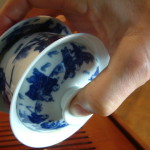 There are many different ways one might use a gaiwan for steeping tea. It can change depending on the type of tea (green, black, etc) used. Then on whether one is leaving the leaves in, pouring the liquor off, using boiling water, a combination of cold and boiling water, using cooler water, and more. All start with a rinse with boiling water that is discarded. This will clean it but more importantly it prevents a rapid drop in temperature of hot water when you begin steeping. After rinsing we prefer one of the following methods below.
There are many different ways one might use a gaiwan for steeping tea. It can change depending on the type of tea (green, black, etc) used. Then on whether one is leaving the leaves in, pouring the liquor off, using boiling water, a combination of cold and boiling water, using cooler water, and more. All start with a rinse with boiling water that is discarded. This will clean it but more importantly it prevents a rapid drop in temperature of hot water when you begin steeping. After rinsing we prefer one of the following methods below.
These instructions are for a gaiwan that holds roughly 6 oz water (roughly 175 cc). Please note that there is wide variation depending on the quality of the tea and your taste preferences. Higher quality tea can often handle many more infusions. In Asia tea masters will often use significantly more leaf for a stronger brew too. Experiment!
Steeping Green, White, or Yellow Tea in a Gaiwan
- Add boiling water to your gaiwan and discard.
- Add 4-5 grams of loose tea to the gaiwan and smell the aroma of the leaf in the hot bowl.
- Carefully, and gently, pour in water that has cooled to about 175° Fahrenheit.
- Wait 20 to 30 seconds.
- Drink directly from the gaiwan using the lid as a filter. (If you prefer you can certainly pour off the liquor in to a cup or mug).
- Repeat steeping at least 2-3 times with with slightly longer times for each infusion.
Steeping Black, Dark and Puerh, or Oolong
 Add boiling water to your gaiwan and discard.
Add boiling water to your gaiwan and discard.- Add 4-5 grams of loose tea to the gaiwan.
- Smell the aroma of the leaf in the hot bowl.
- Add enough boiling water to just cover the tea and discard.
- Add boiling water, cover, and wait 20-30 seconds.
- Pour off the liquor into a cup or mug.
- Refill with boiling water to steep multiple extra times. For black tea this may be at least 2-3 times, oolong may be at least 4-6, and puerh may be as many as 15 times depending on the tea. The number of times you steep can vary widely here and you should keep going as long as you are happy with the flavor.
Finding a gaiwan is relatively easy on-line with lots of choice. Driving to a shop to pick one up is going to be tough unless you live near the Chinatown neighborhoods of New York, San Francisco, Seattle or other major city.
Preparing your tea in a gaiwan provides a great way to learn about Chinese history. From a pure enjoyment perspective you will find that the use of a gaiwan will allow greater exploration of your tea from one infusion to the next. For some of your more delicate teas, you may find that it transforms a seemingly bland tea into a complex sensory experience and will become your go-to steeping vessel.

